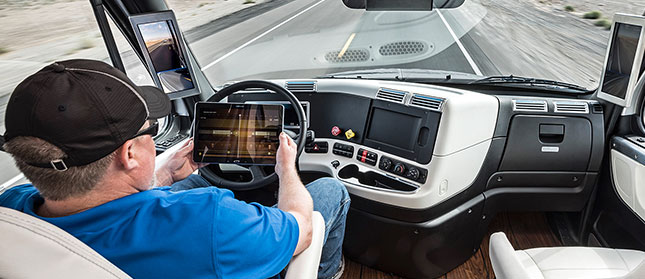
The vice president of the American Transportation Research Institute spoke about autonomous trucks, HOS, e-commerce and other issues at the recent National Private Truck Council conference.
While suggesting that Level 5 autonomous commercial trucks running regular routes probably won’t happen in his lifetime, Dan Murray, noted several level of concerns as well as some of the benefits of the technology, reports FreightWaves.com.
“There may be, probably not in my lifetime, a [purpose] for Level 5 automation, maybe hub and spoke [operations],” he said, before offering a few thoughts on how autonomous vehicles could radically change freight movement.
Murray noted that autonomous vehicles that rarely have to stop would eliminate the current parking problem, and insurance will have to change, particularly around liability concerns. Most issues, he said, are not technology related, though.
“Public perception is going to be a challenge for us,” he said. “It’s going to be a slow learning curve and with that slow learning curve, legislators are going to be [reluctant to offer approvals], so the Teamsters don’t have anything to worry about.”
Throughout his speech, Murray noted some of the research areas that ATRI is focused on, such as getting millennials into the driver workforce, CSA and the item response theory (IRT) approach to safety, truck parking and more. Basically, the list of projects correlates to ATRI’s annual Top Industry Issues List, which in 2017 included the driver shortage and truck parking. ATRI is also working on e-commerce impacts, autonomous vehicles, CDL testing and crash data.
“I tell my friends in Washington, DC, that if you are not addressing one of these issues, you’re not going to get the interest of trucking,” he said.
Here’s the entire list:
- Driver shortage
- Electronic logging device mandate
- Hours of service
- Truck parking
- Driver retention
- Compliance, Safety, Accountability
- Cumulative economic impacts of regulations
- Driver distraction
- Infrastructure/congestion/funding
- Driver health/wellness
Finally, Murray noted the changes taking place in the industry due to e-commerce and predicted that more straight trucks will become part of fleet operations.
“The vast majority of [fleets] in the industry still don’t know how it affects them,” he surmised, noting that trip length is declining but there are more trips taking place and more hub-and-spoke operations.
He also sees more freight moving through personal conveyance, i.e. people delivering goods with their cars. This will impact insurance, Murray said. “Things are going to change dramatically,” he concluded.
Full story here.
